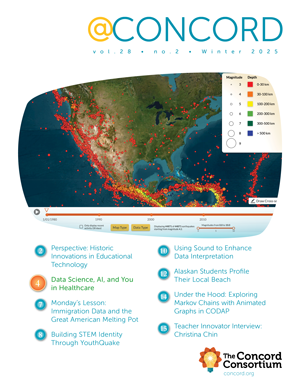Visualizing Student Learning, Modeling an Agricultural System, Temperature and Heat Readiness for Early Elementary Students, and more in spring @Concord.
Perspective: Forging the Future: a Three-fold Path
We are at one of the most exciting—and critical—junctures in the history of educational technology. Rapidly developing technology platforms and devices open doorways for new applications and bring futuristic scenarios into daily reality. Huge venture capital investments and intense interest from education communities fuel an atmosphere of high expectation and excitement. Lessons from decades of learning research amplify the potential for new ideas to make a true difference. We increasingly feel ourselves standing on the brink of something very big.
Visualizing Student Learning
More than fifteen years ago, I worked as a postdoc in computational biophysics. Our dream was to uncover the secrets of life through numerical simulations based on solving foundational equations in physics. We believed that, if we could simulate the motion of every atom and every wave function of a protein or DNA molecule, we could eventually figure out the tricks of biology.
Monday’s Lesson: Modeling an Agricultural System
Everything is connected. That’s the single most important lesson about human interactions with Earth systems. Unfortunately, it’s not that simple to teach.
From Museum to After School: Tracking Learning Across Boundaries
Museums provide distinctive STEM learning opportunities in our everyday lives, and make STEM learning possible in a way unmatched by other facets of society. Museum experiences elicit emotional and sensory responses that resonate for years, provide access to phenomena on inspirational scales and enable personalized experiences with a freedom unequalled by many other learning settings. They also offer learning opportunities to a huge diversity of learners and social groups who visit from a wide range of settings including homes, after school programs and schools.
Sensing Science: Temperature and Heat Readiness for Early Elementary Students
Young children learn through everyday activity. They invent strategies for exploring the world and develop intuitive understandings of phenomena that surround them. Mixing hot and cold water in the bathtub, putting on a winter coat, and feeling the warmth of a fire or a chill climbing out of a swimming pool are personal experiences that instill concepts of temperature and heat. Children generalize data from these experiences to construct theories of temperature and heat well before they enter formal education. We have found that children as young as four years old have definite ideas about the source of heat and how heat moves through air and objects. These early scientific conceptions are often incorrect, but once established, are tenaciously held.
Dragons Go Wild
"This software program fully supports my inquiry-based style of teaching and the students have benefited tremendously from the experience. As they are playing, they are making discoveries that they can then connect to the unit’s concepts and skills."
Under the Hood: Interactive API
To truly tap the potential of deeply digital learning, curriculum authors need a common API for interactives. Currently authors can embed iframes in most content authoring tools. Our new interactive API allows the iframe and surrounding system to communicate with each other, enabling an even richer learning experience.
Innovator Interview: Amy Pallant
Meet Amy Pallant, a Senior Research Scientist at the Concord Consortium. Learn what she was interested in as a kid, how she got into Earth science, and more.
Common Online Data Analysis Platform
Thanks to funding from the National Science Foundation, the Common Online Data Analysis Platform (CODAP) project is creating software that can be used by curriculum developers to get students working with data—in any subject area. CODAP is free and runs in a web browser.






